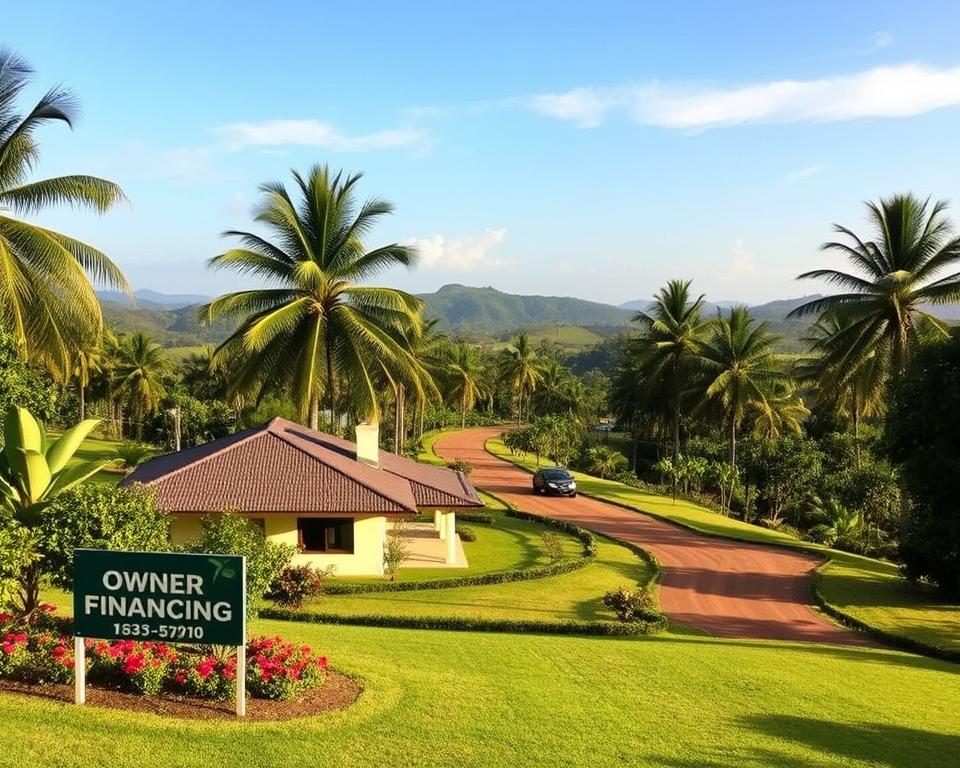Owner financing vs traditional mortgage in Costa Rica Explained
Costa Rica’s residential real estate market is booming, with international buyers driving demand and a projected annual growth rate of 3.88% from 2024 to 2029, reaching over $334 billion USD. At Gap Real Estate (Grupo Gap LLC SRL), we’ve guided numerous clients through seamless transactions with our 20+ years of expertise in Costa Rica real estate.
Financing property in Costa Rica can be complex, especially for foreigners who often struggle to secure traditional mortgages. As a result, alternative financing options have gained popularity. We will explore the pros and cons of owner financing and traditional mortgages, helping you make an informed decision for your investment.
With our expert guidance, you’ll understand the unique aspects of Costa Rica’s property market, including qualification requirements, interest rates, and legal protections. We’ll walk you through the process, ensuring you’re equipped to navigate the local real estate landscape.
Understanding the Costa Rican Real Estate Financing Landscape
The real estate financing landscape in Costa Rica is marked by stability and conservative practices. Costa Rica’s property market is characterized by a history of financial stability, largely due to the country’s conservative lending practices. This stability is reflected in the fact that not a single bank has failed in Costa Rica’s history.
The Unique Aspects of Costa Rica’s Property Market
Costa Rica’s real estate market operates differently from its North American counterparts, with a banking system that prioritizes stability over accessibility. This has resulted in a market where property owners are typically financially stable individuals who have purchased their properties with cash. The conservative lending practices have contributed to fewer foreclosures and more stable property values during economic downturns.
- The country’s banking system is cautious, particularly when it comes to lending to foreigners.
- This cautious approach has led to a stable property market with minimal fluctuations in property values.
Why Financing Options Differ from North America
The limited availability of traditional bank financing in Costa Rica has led to the development of alternative financing methods. Foreign buyers often find that Costa Rican banks rarely approve mortgage applications from non-residents, regardless of their financial stability. Understanding these market dynamics is crucial for foreign investors who may initially assume that financing options will be similar to those in their home countries.
- Alternative financing methods have become standard practice in Costa Rica’s real estate market.
- These alternatives have evolved to accommodate foreign buyers in this distinctive property landscape.
Traditional Mortgages in Costa Rica: The Reality for Foreigners
Costa Rica’s traditional mortgage landscape presents several hurdles for foreigners, making it essential to understand the requirements and challenges involved. For international buyers, the process can be complex and daunting.
Requirements and Qualification Process
Foreigners seeking traditional mortgages in Costa Rica must meet rigorous qualification standards. This includes providing extensive documentation, often translated into Spanish and officially authenticated, along with substantial down payments ranging from 30% to 50% of the property value. A strong credit history and comprehensive proof of income are also mandatory.
Interest Rates and Terms
Traditional bank mortgages in Costa Rica typically offer terms of up to 30 years, with interest rates between 8.5% and 10%. These rates are significantly higher than those in North America and Europe, adding to the financial burden on foreign buyers.
Challenges Foreigners Face with Bank Financing
The banking process in Costa Rica is often slow and inefficient compared to North American standards. Mortgage applications can take months to process, and rejections are common. Additional costs, including higher interest rates and closing costs of up to 3% of the loan amount, further complicate the financing process for foreigners.
We have observed that only a small percentage of our foreign clients have successfully obtained traditional Costa Rican bank mortgages over the past 20 years, highlighting the challenges and complexities involved.
Owner Financing vs Traditional Mortgage in Costa Rica
In Costa Rica, potential property buyers often face a choice between owner financing and traditional mortgage options. This section will delve into the specifics of owner financing, a popular alternative to traditional bank mortgages.
How Owner Financing Works
Owner financing in Costa Rica involves the seller acting as the lender, allowing the buyer to become the legal owner of the property while the seller maintains a mortgage or legal trust against it until the full payment is made. Secure third-party services facilitate these transactions, providing an additional layer of security and transparency.
Under this arrangement, buyers can secure properties with significant down payments, typically 50% or more of the purchase price. The terms are usually short-term, ranging from 1 to 3 years, with interest rates between 6-9%.
Typical Terms and Conditions
Owner financing terms are generally more flexible than traditional mortgages, with shorter durations and potentially lower interest rates. Down payments are typically higher, at 50% or more, and the loan is often structured with a balloon payment.
- Short-term financing (1-3 years)
- Interest rates between 6-9%
- Higher down payments (50% or more)
Legal Protections for Both Parties
Costa Rica’s mortgage laws are robust, providing strong legal protections for both buyers and sellers. Sellers are assured that buyers cannot sell the property without clearing the loan, while buyers are guaranteed the removal of the lien upon full payment.
The cost to register a mortgage is approximately 1.64% of the total mortgage amount, typically borne by the buyer. This adds to the overall cost but provides a secure transaction environment.

Developer Financing: Another Alternative
In Costa Rica’s property market, developer financing emerges as a viable alternative for buyers seeking new construction properties. This financing option is particularly appealing for those who wish to purchase a property without going through traditional bank financing.
When Developer Financing Makes Sense
Developer financing makes sense for buyers who are looking for new construction properties and can afford a significant down payment. It’s an attractive option for those who need flexibility in their payment schedule, as the payments are often aligned with the construction progress.
This financing method is beneficial for buyers who want to avoid the stringent requirements of traditional bank loans. However, it’s crucial for buyers to assess the developer’s financial stability and the quality of their projects before committing to this financing option.
Typical Terms and Down Payment Requirements
Typically, developer financing requires a substantial down payment, often 50% or more of the purchase price. The remaining balance is paid according to a predetermined schedule that usually follows the construction milestones.
- Terms for developer financing are generally shorter, ranging from 2 to 5 years.
- Interest rates may be higher compared to traditional bank rates, but the qualification requirements are more flexible.
- Buyers should work with independent real estate agents and their own attorneys to ensure they are protected throughout the transaction.
By understanding the terms and conditions of developer financing, buyers can make informed decisions about their property investments in Costa Rica.
International Financing Options for Costa Rica Property
For many foreign investors, securing financing for Costa Rica property requires looking beyond local borders. International financing options can provide more flexibility and better terms than traditional local financing methods.
Using Equity Lines of Credit from Your Home Country
Many foreign buyers leverage equity in their home country properties through Home Equity Lines of Credit (HELOCs) to finance Costa Rican real estate purchases. This approach typically offers significantly lower interest rates than Costa Rican financing options and faster approval processes since you’re working with your existing bank.
Self-Directed IRAs for Property Investment
Self-directed IRAs represent another popular financing method, allowing retirement funds to be invested in Costa Rican property. While they offer tax advantages, they come with strict regulations – the property must be treated strictly as an investment, and all rental income must be returned to the IRA.

Working with International Lenders
International lenders specializing in overseas property financing offer more familiarity with foreign buyers’ situations but typically charge higher interest rates than local banks. Financial institutions like Charles Schwab offer the option to borrow against investment portfolios at competitive rates.
Each of these international financing options has distinct advantages and limitations that must be carefully weighed against your specific financial situation and investment goals.
The Financial Implications of Different Financing Methods
When investing in Costa Rica property, understanding the financial implications of different financing methods is crucial. The total cost of property ownership varies significantly depending on the chosen financing method, with each option presenting distinct financial implications.
Comparing Total Costs and Interest Rates
Different financing methods have varying total cost implications over time. Traditional mortgages in Costa Rica typically feature higher interest rates (8.5-10%) but offer longer repayment terms (up to 30 years), potentially resulting in substantially higher total interest paid over the life of the loan. In contrast, owner financing generally comes with lower interest rates (6-9%) and shorter terms (1-3 years), reducing total interest costs but requiring larger down payments (50%+) and potentially creating refinancing challenges when balloon payments come due.
Beyond interest rates, buyers must consider additional costs, including property transfer taxes (1.5% of declared value), legal fees (1-2%), notary fees (1-1.5%), and mortgage registration fees (approximately 1.64% of the mortgage amount). These costs contribute to the total cost of property ownership and should be factored into financial calculations.
Tax Considerations for Foreign Buyers
Tax implications vary by financing method. Interest paid on traditional mortgages may be tax-deductible in some circumstances, while self-directed IRA investments have specific tax advantages but strict usage limitations. Foreign buyers should consider these tax implications when choosing a financing method.
The rental market in Costa Rica is robust, particularly in tourist areas, potentially offsetting carrying costs regardless of financing method. However, income is typically seasonal, with lower returns during the rainy season (May-November). Property value appreciation potential should also be factored into financial calculations, as Costa Rica’s real estate market is projected to grow at 3.88% annually through 2029.
Practical Steps to Secure Financing for Your Costa Rica Property
To successfully finance your Costa Rica property, it’s essential to understand the practical steps involved in the process. Securing financing involves several key stages that require careful planning and preparation.
Documentation Requirements
Gathering the necessary documentation is a critical step in the financing process. For traditional bank financing, you’ll need to prepare comprehensive documentation, including 6-12 months of bank statements, 2-3 years of tax returns, proof of income, credit reports, a valid passport, and property-related documents. All documents typically need to be translated into Spanish and officially authenticated or apostilled.
Working with Local Experts
Engaging with local experts is vital for navigating Costa Rica’s property financing landscape. We recommend working with a reputable real estate agent who has deep local knowledge and an independent attorney specializing in Costa Rican property law. With our 20+ years of experience in Costa Rica real estate, we provide end-to-end support, from documentation preparation to final closing.
Timeline Expectations
Understanding the timeline for securing financing in Costa Rica is crucial. The process can be more leisurely than in North America, with processes that might take days in the US often taking weeks or months in Costa Rica. Adjusting your expectations to the local “Pura Vida” pace is essential for a stress-free experience.
By understanding these practical steps and working with local experts, you can navigate the financing process more effectively and achieve your goal of owning property in Costa Rica.
Conclusion: Making the Right Financing Choice for Your Costa Rica Investment
As you’ve explored the various financing options for your Costa Rica property, it’s clear that the right choice depends on your individual circumstances. Whether you’re seeking a vacation home, retirement property, or pure investment, understanding the full spectrum of financing options empowers you to make the choice that best supports your long-term goals in Costa Rica. At Gap Real Estate, we simplify the entire process from financing selection through closing, ensuring clear communication and dedicated support. Contact us today to discuss your specific financing needs and begin your journey to property ownership in beautiful Costa Rica.




